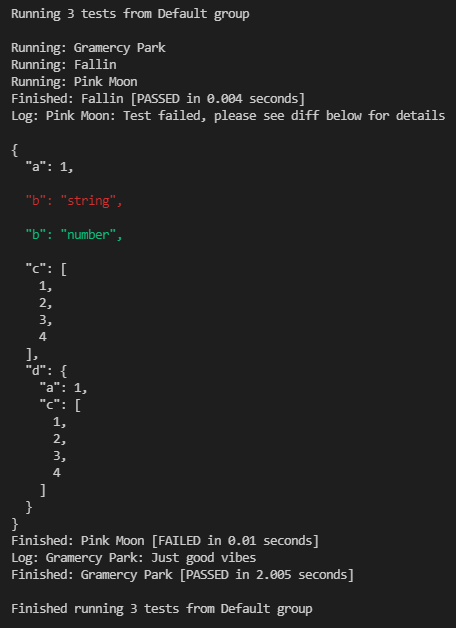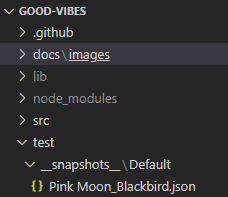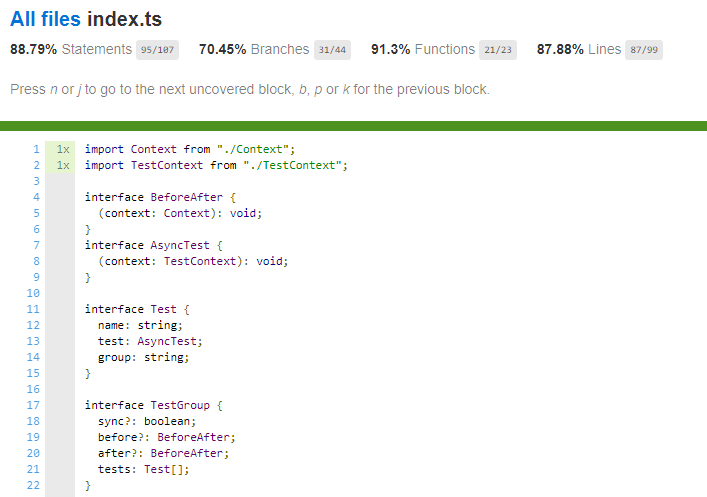good-vibes
Good Vibes is a simple Node.js testing library designed to make writing and executing tests easy and fun.
It was inspired by, and written primarily while listening to, Alicia Keys' Tiny Desk Concert
Installation
npm install good-vibes --save-devGetting started
Lets say you wanted to test the following function defined in code.js
// defined in ./src/code.js
const codeToTest = (firstName, lastName, age) => {
return {
name: {
first: firstName,
last: lastName,
},
age: age
}
}
export codeToTest;
// use the following if you use commonjs style exports
// exports.codeToTest = codeToTestHere is how you would write a test using good-vibes for this function
// defined in ./test/code.test.js
import { codeToTest } from "./src/code";
import run, { test } from "good-vibes";
// alternatively `const { test, run } = require('good-vibes');
test("My first test", (context) => {
const expected = {
name: { first: "Hello", last: "World" },
age: 999,
};
context.log("Lets do this!");
context.check(expected, codeToTest("Hello", "World", 999));
context.done();
});
run(); // runs all your tests defined using the `test` apiTo run this test add a script to your package.json file
{
"name": "my-library",
"version": "0.0.1",
"scripts": {
"test": "node test/code.test.js"
}
}And then on command line type
npm testLets now explain what the above code does
test
The test function allows you to define a test. It has the following signature:
test("name", testFunction, "groupName");name
Name of your test
testFunction
Expects a function with the following signature:
const testFunction = (context) => {
// run your code
// make assertions using context.check(expected, actual)
// mark test as complete using context.done()
};context
A simple utility and assertion framework wrapped within the context of your test and group that provides the following api's:
-
check(expected, actual): uses lodash.isEqual to perform deep equality checks on primitives and objects and more -
done(): marks test as complete -
log(message): log provides a simple wrapper overconsole.logwith the test name prefixed to your message to make them easier to find in the logs -
snapshot(name, actual, updateBaseline): allows for snapshot testing, discussed later in this guide
groupName
Allows you to create a group of tests. More on this below. If not specified the test is assiged to the Default group.
run
Calling the run() api starts the test execution. It accepts a configuration object as follows:
run({
timeout: 300_000, // in milliseconds
snapshotsDirectory: "./test/__snapshots/", // string
});timeout
This is the total amount of time all tests have to run before good-vibes end execution.
Default is set to 5 minutes. After 5 minutes good-vibes will end all test execution and return with error code 1
snapshotsDirectory
Default value is set to ./test/__snapshots__/. For more details see section on Snapshot Testing below.
Running tests from multiple files
TODO
Asynchronous Testing
All tests defined using test are considered to be asynchronous function. This is the reason you need to tell good-vibes that your test is complete by calling the context.done() api.
Here is an example of an asynchronous test
// defined in ./async.test.js
import run, { test } from "good-vibes";
const sayGreeting = async (message) => {
return new Promise((resolve, reject) => {
setTimeout(() => resolve(`Hello, ${message}`), 2000); // resolve value after 2 seconds
});
};
test("Async Test", async (context) => {
// note the async declaration
const actual = await sayGreeting("World!"); // waiting for result
context.check("Hello, World!", actual);
context.done(); // mark test as complete
});
run(); // runs all your tests defined using the `test` apiGrouping tests
The test api supports groupName as the third argument which allows you to groups similar tests together. Groups have the following features:
- Groups always run sequentially one after the other
- All tests inside the group must finish before next group starts
- Tests inside a group run concurrently (unless
syncis called)
- Groups can have setup and teardown code defined using
beforeandafterapi
Example
import run, { before, test, after } from "good-vibes";
const MY_GROUP = "My Group";
let numbers;
let strings;
before((context) => {
// context inside before and after blocks only have done() and log(message) api's
numbers = [1, 2, 3, 4, 5];
context.log("Logging is supported inside before and after blocks as well");
setTimeout(() => {
strings = ["this", "value", "is", "set", "after", "2", "seconds"];
context.done(); // dont forget to call done
}, 2000);
}, MY_GROUP);
test(
"My Test",
(ctx) => {
ctx
.check(5, numbers.length)
.check("1,2,3,4,5", numbers.join(","))
.check(7, strings.length)
.check("this value is set after 2 seconds", strings.join(" "))
.done();
},
MY_GROUP
);
after((ctx) => {
numbers = undefined;
strings = undefined;
ctx.done();
}, MY_GROUP); // group name is important so dont forget it :)
run();before
before function runs once before all tests and has the following signature
before(beforeFunction, groupName); // groupName defaults to 'Default' groupbeforeFunction
beforeFunction has the following signature
const beforeFunction = async (context) => {
// perform your test setup here
// call context.done() once complete
};after
after function runs once after all tests have finished and has the same signature as before
Concise Groups
It can sometimes be verbose to have to specify the group name in each of before, after and test api calls. To make this easier good-vibes provides the group api which wraps all api's with the specified group name.
Lets rewrite the above example now using the group api.
import run, { group } from "good-vibes";
const MY_GROUP = "My Group";
const { before, test, after } = group(MY_GROUP); // wrap good-vibes api's with MY_GROUP groupName
let numbers;
let strings;
before((ctx) => {
numbers = [1, 2, 3, 4, 5];
setTimeout(() => {
strings = ["this", "value", "is", "set", "after", "2", "seconds"];
ctx.done();
}, 2000);
});
test("My Test", (ctx) => {
ctx
.check(5, numbers.length)
.check("1,2,3,4,5", numbers.join(","))
.check(7, strings.length)
.check("this value is set after 2 seconds", strings.join(" "))
.done();
});
after((ctx) => {
numbers = undefined;
strings = undefined;
ctx.done();
});
run();Snapshot Testing
Sometimes the output of a function can be very large - making it cumbersome to test using the context.check api. To help with this good-vibes supports snapshot testing.
Snapshot tests allow you test for changes in the expected output. They do this by maintaining a baseline file with the expected output. Then whenever you run your test the actual output is compared against this baseline file and if they don't match the differences are reported as shown below:
Simple Example
import { group } from "good-vibes";
const { test } = group("Snapshots");
let createLargeObject = (value) => ({
a: value,
b: 123,
c: true,
d: [1, 2, 3, 4, 5],
e: {
f: [
{
a: value,
b: 123,
c: true,
d: [1, 2, 3, 4, 5],
},
],
},
});
test("Large Object", (ctx) => {
// snapshot verifications are asynchronous so you must await its execution
await ctx.snapshot("Check 1", createLargeObject("One"));
// A single test may have one or more snapshot assertions, each snapshot inside a test must have a unique name
await ctx.snapshot("Check 2", createLargeObject("Two"));
// dont forget to call done() at the end
ctx.done();
});
run();In the above example good-vibes will check if the output of createLargeObject matches the snapshot with name Check 1 and Check 2 respectively.
Notes:
- Snapshots internally use JSON.stringify to write the snapshot files, so please be careful while creating snapshots of objects with functions in them
- Order of keys in the object does not matter as the verification is performed on the parsed JSON object and not the json string itself
Snapshot API
The snapshot function allows you to define a test. It has the following signature:
async snapshot<Type>(snapshotName: string, actualValue: Type, rebase?: boolean): Promise<TestContext>Creating or updating a baseline
The first time you run the snapshot test it will fail stating that the baseline file could not be found, similar to the image below:
To create a new baseline or update an existing one, set the third argument of the snapshot api to true
Important Note: When you rebase a snapshot file, good-vibes will automatically fail that test. This is to safeguard against accidental updates to snapshot files and prevent this flag from being committed into source control
Snapshots directory and file structure
Directory Structure
By default good-vibes will create a directory to store all snapshots at this location: ./test/__snapshots__. Inside this folder a new folder is created for each group of tests.
You may override this property by setting the snapshotsDirectory configuration property while calling the run function. See section on run api above for more details.
Snapshot file naming convention
All snapshot files are named using the following convention: <test-name>_<snapshot-name>.json
Overall Structure
Putting the above conventions together, the following template specifies the exact location (using defaults): ./test/__snapshots__/<group-name>/<test-name>_<snapshot-name>.json
In case of our example tests above, following would be the snapshot paths:
./test/__snapshots__/Snapshots/Large Object_Check 1.json
./test/__snapshots__/Snapshots/Large Object_Check 2.json
Example
Synchronous Testing
By default all tests inside a group are considered async and run concurrently. However you may change this behavior at the group level by use of the sync api. The order of the tests in synchronous testing mode is the order of declaration in the test file from top to bottom.
sync api signature
sync(groupName?: string) // groupName defaults to "Default"Using sync api
import run, { before, test, sync } from "good-vibes";
const MY_GROUP = "My Group";
let numbers;
let strings;
before((context) => {
numbers = [1, 2, 3, 4, 5];
strings = ["sample", "values"];
}, MY_GROUP);
test(
"My Test",
(ctx) => {
ctx.check(5, numbers.length).check("1,2,3,4,5", numbers.join(",")).done();
},
MY_GROUP
);
// You can invoke the sync api anywhere in any of your test files
// Because tests only run when the `run()` api is called
// good-vibes will ensure all tests in this group run synchonously
sync(MY_GROUP);
test(
"My Test",
(ctx) => {
ctx
.check(7, strings.length)
.check("sample values", strings.join(" "))
.done();
},
MY_GROUP
);
run();Using the concise groups sync api
import run, { group } from "good-vibes"; // import sync from good-vibes
const MY_GROUP = "My Group";
const { before, test, sync } = group(MY_GROUP);
sync();
let numbers;
let strings;
before((context) => {
numbers = [1, 2, 3, 4, 5];
strings = ["sample", "values"];
});
test("My Test", (ctx) => {
ctx.check(5, numbers.length).check("1,2,3,4,5", numbers.join(",")).done();
});
test("My Test", (ctx) => {
ctx.check(7, strings.length).check("sample values", strings.join(" ")).done();
});
run();Debugging
When you have too many tests in your application, its often useful to be able to run just one or a few failing tests alone to debug the cause of their failure.
good-vibes support this using a special purpose group name called Debug. Debug group name can be used in before, test and after api's and even inside concise groups.
Recommendation: We recommend that you import { DEBUG } from 'good-vibes' instead of redefining the variable yourself. This will isolate your tests from changes to this group name in the future.
Important Note: When running in debug mode good-vibes exits with failure return code 1 - this is to prevent the debug flag from being accidentally committed to source control. The following disclaimer will also be printed in the logs:
Using the Debug group
const run, { before, test, DEBUG } = require("../lib/index");
// When running in debug mode only tests tagged with DEBUG group are run,
// all other tests are skipped
// Good vibes also exits with a return code of 1 to prevent tests from being
// checked into your codebase accidentally
before((ctx) => {
ctx.log("You can run before and after blocks even in debug mode");
ctx.done();
}, DEBUG);
test(
"Johnny Cash",
(ctx) => {
setTimeout(() => {
ctx.log("Hurt");
ctx.check(1, 1).done();
}, 2000);
},
DEBUG
);
run();Concise groups with Debug
import run, { group, DEBUG } from "good-vibes";
const MY_GROUP = "My Group";
const { before, test, sync } = group(MY_GROUP);
let numbers;
let strings;
before((context) => {
numbers = [1, 2, 3, 4, 5];
strings = ["sample", "values"];
}, DEBUG);
// always ensure that you run your before blocks in DEBUG mode too
// if you before some setup for the test being debugged
test(
"My Test",
(ctx) => {
ctx.check(5, numbers.length).check("1,2,3,4,5", numbers.join(",")).done();
},
DEBUG
); // running only one test in DEBUG mode
test("My Test", (ctx) => {
ctx.check(7, strings.length).check("sample values", strings.join(" ")).done();
});
run();Debugging nodejs programs in your IDE
Code Coverage
Code coverage reports can be generated using the nyc package. For up-to-date instruction please check out Installation & Usage section of nyc
Using nyc with good-vibes
First install nyc as a dev dependency
npm install nyc --save-devNext update your package.json scripts section to add a coverage script to run nyc
{
"name": "my-library",
"version": "0.0.1",
"scripts": {
"test": "node test/code.test.js",
"coverage": "nyc --reporter=lcov --reporter=text-summary npm run test"
}
}The above configuration generates a text-summary and a detailed lcov report with html visualization
Text Summary Report
lcov Coverage Report
This can be found inside the /coverage folder, a sample report is shown below:
Examples
- Simple tests can be found in test/simple.test.js
- Test grouping with use of
beforeandaftercan be found in test/groups.test.js - Example of
snapshottests can be found in test/snapshot.test.js - A concise example of groups using the
groupapi can be found in test/concise-groups.test.js - Examples of
synctests can be found in test/synchronous.test.js - Examples of failing tests can be found in test/failing.test.js
- Example of how
debugmode works can be found in test/debug.test.js







